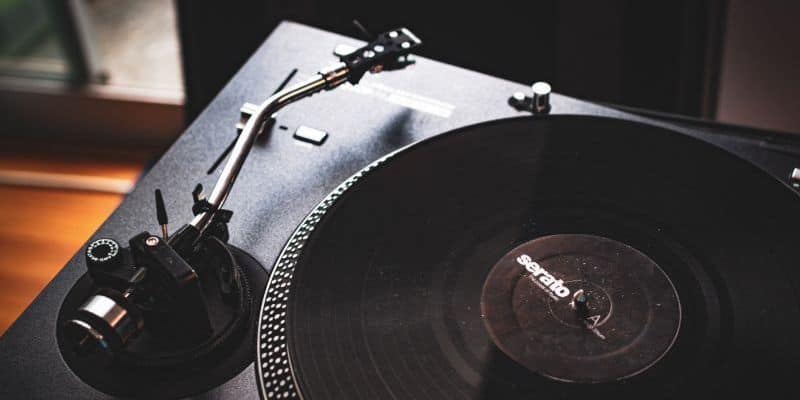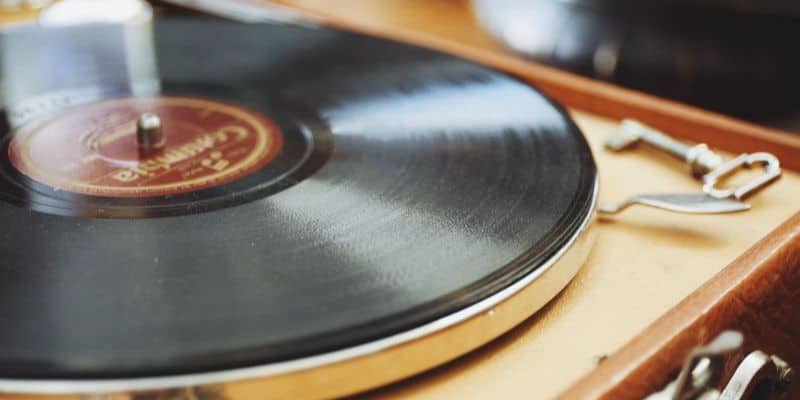Skip to the good bit
ToggleTo ensure your record player stands the test of time, you must look after it as though it’s your most prized possession. Within this guide, we will take you through some must-know record care player tips, as well as how to look after your records. Before you know it, you’ll be back listening to your favourite tunes without a care in the world. Trust us, the effort is worth it!
Why Is My Record Player Dirty?
Annoyingly, record players can get dirty pretty quickly. Some will even need cleaning before each and every play, no matter how thorough you clean it the time before. This is because the static electricity created by vinyl records attracts dust – like a magnet. Even if the dust isn’t too visible, you’ll know it’s there from the quality of sound.
While it’s perfectly normal for record players to attract dust, there are a series of factors that might cause excessive amounts of dust. This includes:
- High amounts of static electricity
- Too much humidity in the room
- Poor storage
- A damaged record player or record.
This probably feels pretty overwhelming at the minute, but you’re in luck. This guide will reveal exactly how to tackle all of the above issues – and more!
The Importance Of Caring For Record Players
Before we dive into the care tips, it’s worth knowing why you should keep up a frequent care routine with your record player.
When a record player gets dirty, dust can accumulate in even the tiniest spots. This dust acts as an obstacle for the mechanisms, causing issues with sound and damaging records. Even the most well-made record players need to be cleaned to work properly!
How To Look After Your Vinyl Record Player
Records that are well cared for can last many years. The complete opposite is true if you neglect care.
It won’t take long for unmaintained record players to become unusable. The more dust that accumulates, the more the sound will crackle and pop. Not only this, but your records will get scratched with every play.
To keep your vinyl records in excellent condition and preserve them for many years to come, keep the following pointers in mind.
Try out: How do vertical record players work?
Equipment Needed:
Don’t worry – you won’t need too many tools to care for your record player. Most equipment can be found lying around the home or purchased online at low prices. You will need:
- Microfiber cloth
- Rubbing alcohol
- Soft bristle brush
- Stylus brush
- Dusting cloth.
Whatever you do, don’t try to use cheap alternatives to cover the equipment you don’t have. Using a toothbrush, for example, could easily scratch your record player and create irreversible damage. It’s far safer to hold off the cleaning process until you have the necessary equipment.

1) Make Sure It’s Set Up Properly
If you’ve purchased a new turntable, it’s likely that the cartridge has already been pre-installed and straightened. A vintage turntable, on the other hand, will almost certainly need to be set up or even serviced.
Using a vintage turntable before checking the above could result in a very stressful scenario. Proper cartridge alignment helps to ensure that the stylus moves through the record’s grooves properly. If incorrect, your stylus may be applying too much pressure to the record grooves, causing harm.
No matter how new or old your record player is, it’s still a good idea to double-check a few essentials before you spin your records. At the very least, make sure that:
- The stylus is in good condition
- The cartridge is aligned properly
- The anti-skating (bias) is correct
- The tracking force is set correctly.
If all of the above is in motion, you’ll have the green light to play safely. If you notice something is wrong, however, adjustments will need to be made before proceeding.
2) Keep On Top Of Dusting
Although this might sound tedious, your record player should be dusted after each use. If this isn’t doable, dust it at least twice a week to avoid dust accumulation. To do so, wipe down all accessible surfaces of your record player with a microfiber cloth – ideally an anti-static one. Start with the centre of the record player and work your way out.
If you notice more dust on the surface than usual, clean it with a wet microfiber cloth and wipe it down in the same motion as you would with a dry one. Make sure there’s no moisture left by wiping down the surface with a dry microfiber cloth afterwards.
Make Dusting Easier With These Tips:
- The stylus is delicate. To avoid warping it, never clean it with your bare hands.
- To prevent dust buildup between uses, make sure the record player is covered with a dust cover. If you do not have dust cover, use a cloth until you can access one.
- Don’t forget that you need to dust your records, too. We’ll unwrap specific vinyl record care tips later in this guide.
3) Brush After Every Use
Once you’ve gently dusted your record player, it’s worth going back over it with a soft bristle brush. This will ensure that any pesky little bits of debris are well and truly gone!
Similarly to how you dusted with the microfibre cloth, wipe all surfaces of the record player with the brush. Be sure to wipe the record player in a downward motion so that the debris falls onto the floor, rather than back on the player.
Top Tip: Be careful not to be too heavy-handed, as extreme pressure may end up scratching the components.
4) Recalibrate Tracking
As mentioned earlier, new record players should come perfectly aligned. Vintage or well-used record players, however, might need some extra TLC. When the tracking is off, you might find that your player skips songs or reduces in sound quality.
To recalibrate tracking, you’ll need to reset the tonearm. This is simple to do:
- Lock the tonearm and remove the needle cover
- Unlock the tonearm’s clamp
- Turn the counterweight until the arm looks balanced
- Secure it back in place, ensuring it doesn’t touch the counterweight.
Once back in place, pop a record on to make sure that your player has been calibrated properly. You will immediately know if something is wrong by the quality of the audio.
5) Stylus Maintenance
If the stylus on your record player is damaged, it will scratch your vinyl records within seconds. Scratched records are near impossible to fix, so you’ll want to avoid this at all costs.
Stylus maintenance is split up into two parts:
- Cleaning the stylus frequently
- Replacing it after 1000 hours of play.
Cleaning The Stylus
Clean your stylus on a regular basis to keep it in excellent working order. To keep on top of this, clean it whenever you dust and brush the player. You can use a specialised stylus cleaner to get rid of any grime, or if you don’t have this to hand, use a stylus brush in gentle motions. Don’t spend too much time cleaning the stylus, as the more you brush it, the more likely it’ll get damaged.
Replacing The Stylus
Most stylus tips will last for up to 1000 hours of playing time. How often you replace it will entirely depend on how much you use the player. However, even if you think your stylus is in good condition, if you care about your player and records, replace it once a year. This will prevent any dreaded scratches!

Your Vinyl Records Need Just As Much Love!
In order to take care of your record player, you must take care of your vinyl records, too. While a dirty record player can damage your records, dirty records can damage your player!
1) Store Records Correctly
When it comes to caring for vinyl records, people often forget about storage. However, this is just as important as all the other tips in this guide. Let’s explain why.
Warped records won’t sit stably on a player, resulting in a warped sound that’s hard to fix. Here are some tips to prevent warping:
- Keep your records vertical and away from humidity. Extreme changes in temperatures can affect the vinyl and torment the grooves.
- Keep your records in their covers when out of use. This will prevent them from gathering dust, which as you know by now, is not ideal for record players!
2) Control The Static
Static electricity can become quite an annoyance when keeping records in good condition. High amounts of static electricity will cause crackles and pops when playing a record, and as mentioned before, cause more dust to accumulate.
An increase in static electricity occurs more often in environments with low humidity, as any moisture on the record’s surface will encourage static. There are a few things that you can do in this instance:
- Antistatic guns: If you learn how to collect vinyl from the experts, the importance of having an antistatic gun to hand will get mentioned a lot. These guns generate negative ions to neutralise the static on the record.
- Replace felt with cork: Replacing your felt turntable with cork will also eliminate the static. This is because cork increases the contact between the record’s surface and the turntable platter.
3) Use Outer & Inner Record Sleeves
Most records come with low-quality paper inner sleeves and no additional outer sleeve protection.
Inner sleeves made of low-cost paper offer little protection for a record. They leave paper flakes on the record and, over time, can result in scuffs and scratches. Not only this, but the lack of antistatic qualities in paper sleeves makes it prone to picking up scratches as the record is pulled in and out of the sleeve.
We highly recommend replacing the old, flimsy paper outer sleeves with decent quality polyethene sleeves. These types of outer sleeves will prevent dust from accumulating and prevent the cover art from wearing down. You can purchase these online for low prices, especially if bought in bulk.
4) Handle Your Records With Care
When it comes to record maintenance, avoid direct contact as much as possible! Even if your hands are clean, the natural oils from your skin will harm the record’s surface. This will not only affect the sound quality, but make the record look greasy, too.
We’re not saying you need to put on gloves every time you handle your records, but do pay attention to how you hold them. When pulling the record out of its sleeve, avoid putting your fingertips on its actual surface. Instead, lightly hold the record on its side.
5) Gently Clean Your Records
Just like your record player, you should clean your records as often as possible. There are many ways to go about this, and the decision will be based on how grubby the records are.
Cleaning By Hand
Cleaning by hand is the best option if you’re on a budget or wish to save time.
- To begin, use a vinyl brush to gently clean the record’s surface in a circular pattern. Do not apply too much force. Applying too much pressure will damage the grooves and affect sound quality.
- Use a vinyl record cleaning solution or a combination of dish soap and water. Gently rub over the record.
- Once washed, dry with a microfiber towel.
- Keep the records out for at least half an hour after drying them. If there is too much moisture, it can lead to mould growth on the record sleeve, which might cause significant vinyl damage.
Cleaning Machines
Using a record cleaning machine is by far the most thorough and efficient way to clean your records. However, it’s not the cheapest.
Record cleaning machines are great at removing gunk and grime from your records. They work by submerging your vinyl records in a cleaning solution and distilled water. All you have to do is gently turn the record through the cleaning solution while the built-in cleaning pads do all of the work. Easy, right?
Frequently Asked Questions
Can I Use A Toothbrush To Clean My Record Player?
No. Even a soft-bristled toothbrush can cause damage, which is why you should never go near a record player with a toothbrush. Instead, use a soft-bristled brush designed for record player maintenance.
Do The Tips In This Guide Apply To All Record Players?
Yes. All record players should be cleaned after each usage and you should aim to do a deep clean at least once a month (providing you use the player a lot).
How Long Does A Turntable Stylus Last?
The stylus is the most fragile component of a record player. It comes into close touch with dirt, rubbish, and debris with every play, making it prone to damage.
Aside from continual contact with dust, frequent playing and hours of use can harm the stylus as well. If you fail to keep a close eye on the needle and monitor how long it’s been there, as well as when and how often you use it, your valued vinyl records may end up damaged.
As a general rule of thumb, you should replace your stylus after every 1,000 plays. You should also replace it if it’s showing signs of deformities or jagged edges. If you buy second hand vinyl or a vintage record player, you should check this right away.
How Do You Change A Needle On A Record Player?
Before changing the needle, make sure the record player is unplugged.
- With your non-dominant hand, pinch the head of the needle to keep it still.
- With your dominant hand, grip the plastic or metal case that surrounds the stylus.
- Remove the old stylus by pinching the sides and pulling it out. To prevent damaging the cartridge, slide the stylus away from it while maintaining a parallel relationship.
Can A Cheap Record Player Damage Records?
Yes. Some lesser-priced turntables (that often show up when searching for gifts for vinyl lovers!) include a low-quality stylus that might harm your records from the get-go. This is why it’s worth investing in a higher quality turntable made from more durable and reliable materials.
In Summary
While you might feel like record player care is hard work, the time and effort spent looking after your belongings will pay off in the long run. Maintaining a care routine will increase the longevity of your record player and guarantee crisp audio for many years to come.
Don’t forget that your vinyl records need just as much love as your record player does. Without clean records, your record player won’t perform! So, through a series of dusting routines, the correct storage and thorough inspections, you’ll be a proud record player owner for years to come.










